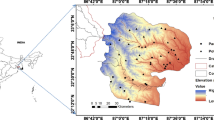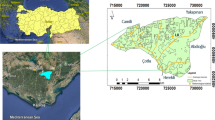Abstract
Crop coefficient (Kc) represents the actual crop growth of the crop. It plays an important role in estimating water requirements at the different growth stages of the crop. However, FAO 56 Penman–Monteith Kc method does not account for spatial heterogeneity and uncertainty for regional climatic conditions significantly. Therefore, this study aims to develop the relation between Kc and normalized difference vegetation index (NDVI) using a linear regression and back calculations. These relationships were adjusted to local conditions using information from survey data obtained during Rabi season (2014–2015). The NDVI–Kc model (r2 = 0.86) has developed using NDVI–Kc from a fine resolution Landsat 8 remote sensing data. NDVI–Kc regression equation was utilized for generating crop coefficient for different month of season. The Vegetation Index-based AET estimated was evaluated with lysimeter data for different crop growth stage across the season. The results have shown that NDVI–Kc estimated AET has been better correlated with NDVI–Kc remote sensing model. Thus, the output of this research can help to calculate actual water demand in a command area and be helpful in allocating water from less demand area toward more demand area.










Similar content being viewed by others
Data Availability
The authors confirm that the data supporting the findings of this study are available within the article.
References
Adamala, S., & Srivastava, A. (2018). Comparative evaluation of daily evapotranspiration using artificial neural network and variable infiltration capacity models. Agricultural Engineering International: CIGR Journal, 20(1), 32–39
Allen, R. G., Pereira, L. S., Raes, D., & Smith, M. (1998). Crop evapotranspiration—Guidelines for computing crop water requirements—FAO Irrigation and Drainage Paper 56. Food and Agriculture Organization.
Brocca, L., Tarpanelli, A., Filippucci, P., Dorigo, W., Zaussinger, F., Gruber, A., & Fernández-Prieto, D. (2018). How much water is used for irrigation? A new approach exploiting coarse resolution satellite soil moisture products. International Journal of Applied Earth Observation and Geoinformation, 73, 752–776
Doorenbos, J., Pruitt, W. O. (1977). Guidelines for predicting crop water requirements. FAO Irrigation and Drainage Paper No 24, FAO, Rome, Italy.
Elbeltagi, A., Aslam, M. R., Malik, A., Mehdinejadiani, B., Srivastava, A., Bhatia, A. S., & Deng, J. (2020). The impact of climate changes on the water footprint of wheat and maize production in the Nile Delta, Egypt. Science of the Total Environment, 743, 140770
Elbeltagi, A., Kumari, N., Dharpure, J. K., Mokhtar, A., Alsafadi, K., Kumar, M., Mehdinejadiani, B., Ramezani Etedali, H., Brouziyne, Y., Islam, T., & Md, A. R. (2021). Prediction of combined terrestrial evapotranspiration index (CTEI) over large river basin based on machine learning approaches. Water, 13(4), 547
Gontia, N. K., & Tiwari, K. N. (2010). Estimation of crop coefficient and evapotranspiration of wheat (Triticum aestivum) in an irrigation command using remote sensing and GIS. Water Resources Management, 24(7), 1399–1414
Jalilvand, E., Tajrishy, M., Hashemi, S. A., & Brocca, L. (2019). Quantification of irrigation water using remote sensing of soil moisture in a semi-arid region. Remote Sensing of Environment, 231, 111226
Kamble, B., Kilic, A., & Hubbard, K. (2013). Estimating crop coefficients using remote sensing-based vegetation index. Remote Sensing, 5(4), 1588–1602
Karthikeyan, L., Chawla, I., & Mishra, A. K. (2020). A review of remote sensing applications in agriculture for food security: Crop growth and yield, irrigation, and crop losses. Journal of Hydrology, 586, 124905
Kumar, U., Panday, S. C., Kumar, J., Meena, V. S., Parihar, M., Singh S., Bisht, J. K., & Kant, L. Comparison of recent rainfall trend in complex hilly terrain of sub-temperate region of Uttarakhand. J-065(6429), Mausam (Accepted)
Kumar, U., Sahoo, B., Chatterjee, C., et al. (2020). Evaluation of simplified surface energy balance index (S-SEBI) method for estimating actual evapotranspiration in Kangsabati reservoir command using landsat 8 imagery. Journal of the Indian Society of Remote Sensing, 48, 1421–1432
Kumari, N., Saco, P. M., Rodriguez, J. F., Johnstone, S. A., Srivastava, A., Chun, K. P., & Yetemen, O. (2020). The grass is not always greener on the other side: Seasonal reversal of vegetation greenness in aspect-driven semiarid ecosystems. Geophysical Research Letters, 47(15), e2020GL088918
Kumari, N., & Srivastava, A. (2020). An approach for estimation of evapotranspiration by standardizing parsimonious method. Agricultural Research, 9, 301–309. https://doi.org/10.1007/s40003-019-00441-7
Laio, F., Porporato, A., Ridolfi, L., & Rodriguez-Iturbe, I. (2001). Plants in water-controlled ecosystems: active role in hydrologic processes and response to water stress: II. Probabilistic soil moisture dynamics. Advances in Water Resources, 24(7), 707–723
Lee, S., et al. (2016). Impacts of watershed characteristics and crop rotations on winter cover crop nitrate-nitrogen uptake capacity within agricultural watersheds in the Chesapeake Bay Region. PLoS ONE, 11(6), e0157637
Li, S., Kang, S., Zhang, L., Zhang, J., Du, T., Tong, L., & Ding, R. (2016). Evaluation of six potential evapotranspiration models for estimating crop potential and actual evapotranspiration in arid regions. Journal of Hydrology, 543, 450–461
Malik, A., Kumar, A., & Kisi, O. (2017). Monthly pan-evaporation estimation in Indian central Himalayas using different heuristic approaches and climate based models. Computers and Electronics in Agriculture, 143, 302–313
Maza, M., Srivastava, A., Bisht, D. S., Raghuwanshi, N. S., Bandyopadhyay, A., Chatterjee, C., & Bhadra, A. (2020). Simulating hydrological response of a monsoon dominated reservoir catchment and command with heterogeneous cropping pattern using VIC model. Journal of Earth System Science, 129(1), 1–16
Mishra, P., Tiwari, K. N., Chowdary, V. M., & Gontia, N. K. (2005). Irrigation water demand and supply analysis in the command area using remote sensing and GIS. Hydrogeology Journal IAH, 28(1–2), 59–69
Mittal, N., Mishra, A., Singh, R., Bhave, A. G., & van der Valk, M. (2014). Flow regime alteration due to anthropogenic and climatic changes in the Kangsabati River, India. Ecohydrology and Hydrobiology, 14(3), 182–191
Pereira, L. S., Allen, R. G., Smith, M., & Raes, D. (2015). Crop evapotranspiration estimation with FAO56: Past and future. Agricultural Water Management, 147, 4–20
Ray, S. S., & Dadhwal, V. K. (2000). Estimation of evapotranspiration of irrigation command area using remote sensing and GIS. Agricultural Water Management, 49, 239–249
Reginato, R. J., Jackson, R. D., & Pinter, P. J., Jr. (1985). Evapotranspiration calculated from remote multispectral and ground station meteorological data. Remote Sensing of Environment, 18(1), 75–89
Roerink, G. J. (1994). The impact of satellite sensor resolution on the regional evaporation statistics in large-scale irrigation schemes, a case study in the Mendoza Province, Argentina. M.Sc. thesis, Internal Note 312, DLO-Winand Staring Centre, Wageningen, The Netherlands, 58 pp
Roerink, G. J., Bastiaanssen, W. G. M., Chambouleyron, J., & Menenti, M. (1997). Relating crop water consumption to irrigation water supply by remote sensing. Water Resources Management, 11(6), 445–465
Saadi, S., et al. (2015). Monitoring irrigation consumption using high resolution NDVI image time series: calibration and validation in the Kairouan Plain (Tunisia). Remote Sensing, 7(10), 13005–13028. https://doi.org/10.3390/rs71013005
Senay, G. B., Friedrichs, M., Singh, R. K., & Velpuri, N. M. (2016). Evaluating Landsat 8 evapotranspiration for water use mapping in the Colorado River Basin. Remote Sensing of Environment, 185, 171–185
Senay, G. B., Schauer, M., Friedrichs, M., Velpuri, N. M., & Singh, R. K. (2017). Satellite-based water use dynamics using historical Landsat data (1984–2014) in the southwestern United States. Remote Sensing of Environment, 202, 98–112
Srivastava, A., Deb, P., & Kumari, N. (2020a). Multi-model approach to assess the dynamics of hydrologic components in a tropical ecosystem. Water Resources Management, 34, 327–341
Srivastava, A., Kumari, N., & Maza, M. (2020b). Hydrological response to agricultural land use heterogeneity using variable infiltration capacity model. Water Resources Management, 34, 3779–3794
Srivastava, A., Sahoo, B., Raghuwanshi, N. S., & Chatterjee, C. (2018). Modelling the dynamics of evapotranspiration using variable infiltration capacity model and regionally-calibrated Hargreaves approach. Irrigation Science, 36, 289–300
Srivastava, A., Sahoo, B., Raghuwanshi, N. S., & Singh, R. (2017). Evaluation of variable infiltration capacity model and MODIS-terra satellite-derived grid-scale evapotranspiration estimates in a river basin with tropical monsoon-type climatology. Journal of Irrigation Drainage Engineering, 143(8), 04017028
Srivastava, A., Saco, P. M., Rodriguez, J. F., Kumari, N., Chun, K. P., & Yetemen, O. (2021). The role of landscape morphology on soil moisture variability in semi-arid ecosystems. Hydrological Processes, 35, e13990. https://doi.org/10.1002/hyp.13990
Wisser, D., Frolking, S., Douglas, E. M., Fekete, B. M., Vörösmarty, C. J., & Schumann, A. H. (2008). Global irrigation water demand: Variability and uncertainties arising from agricultural and climate data sets. Geophysical Research Letters, 35, 1–5
Yeo, I. Y., Lee, S., Sadeghi, A. M., Beeson, P. C., Hively, W. D., McCarty, G. W., & Lang, M. W. (2014). Assessing winter cover crop nutrient uptake efficiency using a water quality simulation model. Hydrology and Earth System Sciences, 18(12), 5239–5253
Zhang, B., Liu, Y., Xu, D., Zhao, N., Lei, B., Rosa, R. D., Paredes, P., Paço, T. A., & Pereira, L. S. (2013). The dual crop coefficient approach to estimate and partitioning evapotranspiration of the winter wheat-summer maize crop sequence in North China Plain. Irrigation Science, 31(6), 1303–1316
Zhang, B. Z., Xu, D., Liu, Y., Li, F. S., Cai, J. B., & Du, L. J. (2016). Multi-scale evapotranspiration of summer maize and the controlling meteorological factors in north China. Agricultural and Forest Meteorology, 216, 1–12
Zhang, Y. K., & Schilling, K. E. (2006). Increasing streamflow and baseflow in Mississippi River since the 1940 s: Effect of land use change. Journal of Hydrology, 324(1–4), 412–422
Acknowledgements
This work is carried at IIT Kharagpur at Geographic Information system (GIS) laboratory group under Professional Attachment Training (PAT). We acknowledge the Ministry of Human Resources Development and IIT Kharagpur for providing the necessary fellowship and facility during M. Tech. as well as Indian Council of Agricultural Research (ICAR), New Delhi, and ICAR-Vivekananda Parvatiya Krishi Anusandhan Sansthan, Almora 263601 for providing financial support during PAT. We also acknowledge the Agricultural and Food Engineering Department, IIT Kharagpur, for providing necessary technical facilities during the course of investigation.
Author information
Authors and Affiliations
Corresponding author
Ethics declarations
Conflict of interest
No potential conflict of interest was reported by the authors.
Additional information
Publisher's Note
Springer Nature remains neutral with regard to jurisdictional claims in published maps and institutional affiliations.
About this article
Cite this article
Kumar, U., Srivastava, A., Kumari, N. et al. Evaluation of Spatio-Temporal Evapotranspiration Using Satellite-Based Approach and Lysimeter in the Agriculture Dominated Catchment. J Indian Soc Remote Sens 49, 1939–1950 (2021). https://doi.org/10.1007/s12524-021-01367-w
Received:
Accepted:
Published:
Issue Date:
DOI: https://doi.org/10.1007/s12524-021-01367-w




